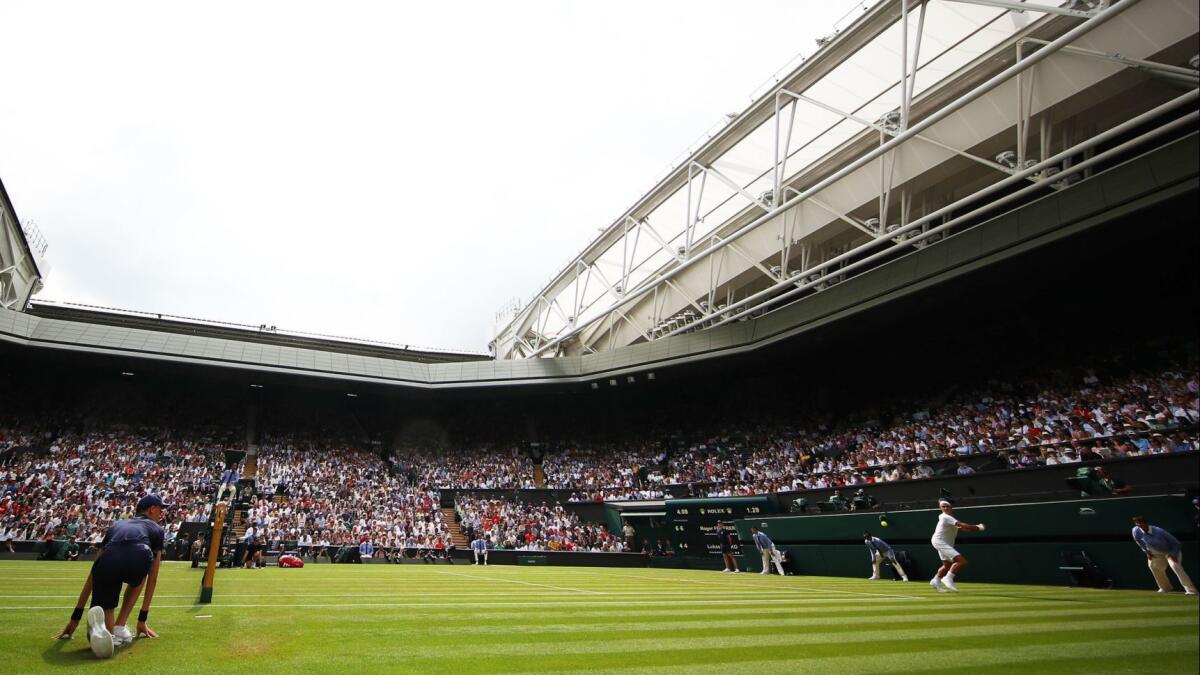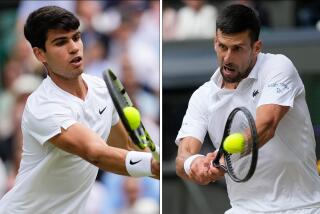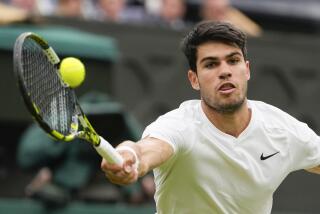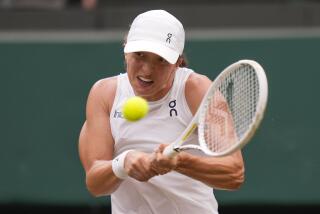Wimbledon is the ultimate pilgrimage for tennis fans and those who love tradition
Reporting from Wimbledon, England — There’s something unique about Wimbledon. Sure, the Australian Open offers a seemingly nonstop party; the French Open maintains its elegant, distinctive flavor; and the intensity and enormity of the U.S. Open crowds gives it an only-in-New-York flavor, but still ...
Wimbledon has the deepest roots, the most particular traditions and, of course, all that grass.
Here’s another way Wimbledon stands apart: The four Grand Slam tournaments offer behind-the-scenes tours, but only Wimbledon complements that with a full-fledged museum that explores the tournament and the broader history of the game. (The French Open’s tour and its smaller museum have been closed for years during renovations to Roland Garros stadium.)
Even the Wimbledon tour’s restrictions seem special. You don’t have to wear all white, but you cannot visit the players’ locker rooms, a highlight of the Australia and New York tours. That’s because only Wimbledon is a private club, open year-round to members who could be getting dressed or undressed.
Because a singles title brings instant membership, it’s within the realm of possibility that Pete Sampras and Andre Agassi or Steffi Graf and Martina Navratilova are changing into their gear to play a set. (No, we didn’t see any past champions roaming the club during our tour.)
The 90-minute tour does, however, cover plenty of ground both in sights and in anecdotes. (No tours are available during the Wimbledon tournament — July 1-14 this year — but the museum is open year-round.)
Tours begin with a brief history lesson, a story that could take place only in a 19th century English village. The club dates to the 1860s, when it was down the road and the emphasis was on croquet. Only in 1877 did this newfangled sport become popular enough that the name was changed to the All England Croquet and Lawn Tennis Club.
In 1877, the pony roller, used to maintain the grass just so, broke down. To cover the repair costs, members held a tennis tournament (men only), charging fans for tickets and players an entry fee. Spencer Gore won the final before a crowd of 200.
Today, Gore is largely forgotten, Wimbledon left its home for new digs nearly a century ago, pony rollers are no longer cutting-edge technology, but the tours and Wimbledon museum now draw more than 200 fans every day. On our tour, visitors hailed from Germany, Mexico and other countries.

The tour’s most important rule is, naturally, about the grass.
“Don’t touch it, don’t sniff it, don’t lick it,” Alex, our guide, said. “The grass is sacred. Leave it alone.”
The grass is protected by fencing so it’s easy to resist temptation. In winter, when you see eight patches of grass with no lines and no nets, it looks more like a park waiting for spring and sunbathers.
The line markings are added in May. The grass is grown to .59-inch tall during the off-season, then trimmed to about .32-inch for the tournament. During off-season tours you’ll see massive grow lights and large fans that dispel moisture to prevent fungal spores.
The tour reveals a classic Wimbledon quirk on the Honor Boards under Centre Court, where you’ll see the Gentlemen’s and Ladies’ Champions: The two-time champion Miss C.M. Evert and subsequent winner Mrs. J.M. Lloyd are the same person, but the club’s traditional approach to women’s married names imposed this identity switch on Chris Evert after she wed John Lloyd.
You’ll visit the member and players’ entrance, where everyone — even Roger Federer — must check in at the front desk upon arrival. You’ll also see the Prize Money Office, where players collect their winnings; ironically, except for the champions, the “winnings” are collected after a player loses.
A visit to the media center leads to the BBC Sports studio, though the building’s highlight is the roof, which offers a view of many of the courts, starting with Court 18, where John Isner endured his infamous 70-68 fifth set win over Nicolas Mahut in 2010, and the famous Henman Hill where fans gather to watch matches on a big screen.
The tour’s two main attractions are Interview Room 1 and Centre Court. The interview room is smaller and cozier than the one at the U.S. Open, and everyone can have their picture taken on the dais as if facing the press after a match.
Wimbledon tradition dictates that each player has a host member who acts as a point person and accompanies him or her to the dais. “There is a rivalry to see who gets which player,” Alex said.
Centre Court, with fewer than 15,000 seats, feels more intimate than Arthur Ashe or even Louis Armstrong Stadium at the U.S. Open. You can see the royal box and the single box for both players’ families; at Wimbledon, unlike at other Slams, the families must sit together.
A scoreboard replica displays last year’s men’s final score — Novak Djokovic defeated Kevin Anderson, 6-2, 6-2, 7-6 — until the new tournament begins.
Meanwhile, the Wimbledon Lawn Tennis Museum wonderfully juxtaposes the old (history and artifacts) with the new (Kevin Anderson’s shoes, Mike Bryan’s racket, Federer’s shirt and a virtual-reality experience).
The exhibit starts with the predecessors of the modern game, such as jeu de palme (played without rackets) and real tennis (in which the walls are in play). One display underscores how quickly the modern game caught on, with antique napkin rings, toast racks and lemon squeezers all adorned with tennis rackets.
Another area shows the evolution of the rackets, including an early attempt at a larger head size that failed because wooden rackets couldn’t handle the string tension and quickly warped. (The audio guide provides extra details for each display.)
Interactive exhibits let you feel how much heavier women’s outfits were in the 19th century when they were burdened by corsets. The museum also explains that in 1905 May Sutton “caused a stir by playing with her sleeves rolled up because she was hot.”
A rules quiz features memorable oddities: What do you do if a shot hits a pigeon (replay the point) or the umpire’s nose (out, even if the ball lands in because the umpire is considered a “permanent fixture”).
There are brief biographies of the game’s greatest stars from the earliest days on, such as William Renshaw, the Federer of his time (winning Wimbledon seven times in the 1880s) and his twin brother, Ernest, with whom he pioneered the doubles tactic of having both players at the net.
By the time the exhibit reaches 1920s legends such as Bill Tilden and Helen Wills Moody, there are video highlights. For the 1940s through ’60s, videos detail the changing game and offer glimpses of the equally dramatic changes in the fashions worn by fans even as the players’ dress code remained.
The pièce de résistance in terms of technology, however, is the virtual-reality experience, which uses 360-degree camera technology to put you in the middle of the action during the 2016 men’s and women’s finals.
The museum culminates with a display of the champions’ trophies, a fitting reminder that Wimbledon is unique not just for the fans but for the players as well.
If you go
THE BEST WAY TO LONDON
From LAX, Air New Zealand, British, Virgin Atlantic, American, Delta, United and Norwegian offer nonstop service to London. Restricted round-trip airfare from $994, including taxes and fees.
By Underground, you take the District Line toward Wimbledon and exit at the Southfields Station. From there you can either take the 493 bus, a five-minute ride or you can walk (approximately 4/5 of a mile) for 15 minutes, along Wimbledon Park Road, which becomes Church Road and leads you directly to the Wimbledon Lawn Tennis Museum at Gate 4.
WHERE TO STAY
If you want to stay in or near the village of Wimbledon:
Hotel du Vin & Bistro, Cannizaro House, West Side Common, London; 011-44-33-0024-0706, hotelduvin.com/locations/wimbledon. The gorgeous building dates to the 19th century and has hosted guests from Lord Tennyson to Oscar Wilde. Doubles from $150.
Dog & Fox, 24 High St., Wimbledon Village, London; 011-44-20-8946-6565, dogandfoxwimbledon.co.uk. A luxury hotel in an elegant building with 17 boutique rooms and decor that plays off the hotel name. Doubles from $150.
If you prefer staying closer to central London, there are a zillion options. Here are two:
Sydney House Chelsea, 9-11 Sydney St., Chelsea, London; 011-44-20-7376- 7711, sydneyhousechelsea.co.uk. A sleek but homey 21-room near Hyde Park. Doubles from $230.
Ibis Styles London-Southwark, 43-47 Southwark Bridge Road, London; 011-4 20 7015 1480, bit.ly/ibisstylessouthwark. This 114-room hotel, with a flamboyant design motif, is three blocks from Shakespeare’s Globe and less than half a mile from the Tate Modern. Doubles from $275.
WHERE TO EAT
Wingfield Restaurant; 011-44-20-8247-3142, bit.ly/wingfieldrestaurant. If you want to eat between your tour and your trip to the museum, the Wingfield, on the grounds at Wimbledon, serves soup, sandwiches, panini, pizza and the Wimbledon Groundsman’s Platter (a pork pie with ham and cheese). Prices $7.25 to $11.50
The Fox & Grapes, 9 Camp Road, Wimbledon, London; 011-44-20-8619-1300, foxandgrapeswimbledon.co.uk. A cozy pub (with hotel rooms upstairs) on the edge of Wimbledon Common. The building dates to 1787, but the English fare is wonderfully modern. Entrees $8 to $34.
Holy Smoke, 21 Leopold Road, Wimbledon, London; holysmoke.london.The restaurant emphasizes fresh ingredients and puts almost everything in its smoker. The menu changes regularly but can include seared pigeon, roasted guinea fowl and smoked sesame tofu. Entrees $24 to $32.
TO LEARN MORE
Wimbledon Lawn Tennis Museum, Church Road, Wimbledon, London; 011-44-20-8946-6131, bit.ly/wimbledonmuseum. The museum is open 10 a.m. to 5:30 p.m. Last admission is at 5 p.m. Tours run every half-hour and last 90 minutes. Tours are not given during the Wimbledon tournament, but the museum is open. An adult ticket for just the museum is $17, for the museum and the tour it is $33.
More to Read
Sign up for The Wild
We’ll help you find the best places to hike, bike and run, as well as the perfect silent spots for meditation and yoga.
You may occasionally receive promotional content from the Los Angeles Times.






